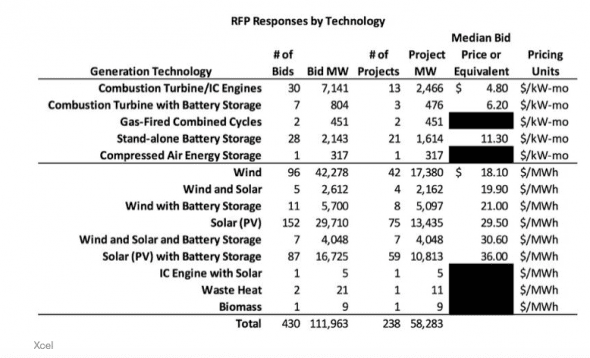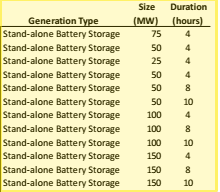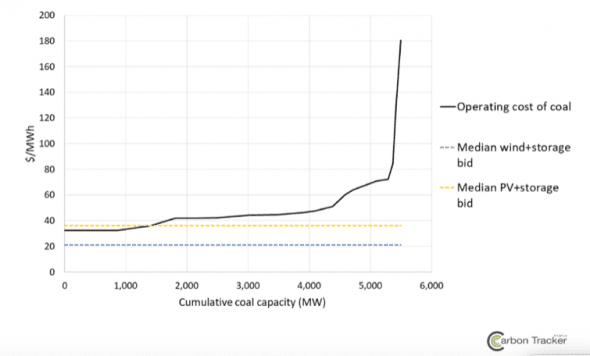The plunging cost of storage, along with that of wind and solar power, appears to have crossed a new threshold after a tender conducted by a major US energy utility suggests “firm and dispatchable” renewables are now cheaper than existing coal plants.
The stunning revelation came from Xcel Energy in Colorado, and quietly released over the Christmas/New Year break, although some outlets like Vox and Carbon Tracker were quick to pick up on the significance.
Last year, XCel Energy put out a “request for proposals” (RFP) for how it could replace two coal-fired generators that it is considering shutting down – part of a plan that will take its share of renewables to more than 50 per cent.
The results were described by Vox’s David Roberts as “mind-blowing”. And he’s not wrong.
 The median bid price for projects proposing a mix of wind plus battery storage was just $US21/MWh ($A25.80/MWh), while the median price for solar plus battery storage projects was just $US36/MWh ($A44.30/MWh).
The median bid price for projects proposing a mix of wind plus battery storage was just $US21/MWh ($A25.80/MWh), while the median price for solar plus battery storage projects was just $US36/MWh ($A44.30/MWh).
(The graph above comes from the XCel documents. The areas blacked out were done by the utility for reasons of commercial in confidence).
And these prices do not represent just a few one-off, left field offers. All told, there were more than 100 bids combining wind and solar, or both, with battery storage, and 20 gigawatts of such capacity.
The “median” means that half the bids were cheaper than the median price cited above.
According to Carbon Tracker, these are the lowest renewables plus battery storage bids in the US to date, and most likely anywhere in the world.
“The median bid for wind plus storage appears to be lower than the operating cost of all coal plants currently in Colorado, while the median solar plus storage bid could be lower than 74 per cent of operating coal capacity,” it noted in a report earlier this month.
The significance of the tender result is the small additional cost of storage – between $US3 and $US7/MWh. This is less than half the $US15/MWh priced in the previous lowest bid – $US45/MWh for solar and storage in a bid accepted by Tucson Energy easier last year.
The cost of wind without storage was $18/MWh, while the cost of solar without storage was $29/MWh – both prices benefit from federal tax incentives, and would likely be around $US25/MWh and $US40/MWh without them.
The significance for Australia is enormous. The battery storage sector has only just commenced, but the potential is clearly huge.
The success of the Tesla big battery in South Australia since its launch in early December has created great interest, and caused many to think how the operations of the electricity grid may be completely rethought and redesigned.
The Tesla big battery will be joined by numerous other battery storage installations in a relatively short time – smaller battery arrays in Alice Springs and near Cooktown in Queensland are due to come on soon, as will another battery at the Wattle Point wind farm in South Australia.
This will be followed by three new battery storage arrays in Victoria, another in the Northern Territory, at least two more in South Australia (Lincoln Gap and Whyalla) and numerous other potential projects in Queensland and NSW.
It was interesting that Franck Woitiez, the head of Neoen Australia which operates the Tesla big battery adjacent to its Hornsdale wind farm, last week spoke of the huge pipeline of solar projects in NSW – more than 2,000MW – that could readily adopt battery storage.
Woitiez noted how quickly the 150MW Coleambally solar project in western NSW will be delivered – less than two years after the project was first conceived – and said large scale solar and storage could be delivered in half the time, and at a much lower cost, than the massive Snowy 2.0 pumped hydro scheme.
The US tender bears that out. Wind, solar and storage costs in the US tend to be cheaper than in Australia, partly due to the lower cost of finance, the lower cost of labour, and the depth of the industry there.
The Xcel tender results are just part of story that illustrates the plunging cost of wind, solar, and battery storage. Bids of below $US20/MWh for solar projects have now been delivered in both Saudi Arabia and Mexico, and storage is matching predictions that its cost profile will be similar to solar.
 The Xcel tender elicited bids for stand alone battery storage with a media price of $US11/MWh, with storage ranging from
The Xcel tender elicited bids for stand alone battery storage with a media price of $US11/MWh, with storage ranging from
As Vox’s Roberts notes, a company called ViZn Energy Systems, which uses flow batteries rather than lithium-ion, is promising $US27/MWh solar+storage by 2023.
That is lower than many predictions for solar alone. When the Tucson bid results were announced, it was considered to be a death knell for the market for new gas plants.
As Danny Kennedy, formerly on Sungevity and now head of the California Clean Energy Fund, has noted, both GE and Siemens have taken an axe to their once enormous gas generation units because of the massive slump in orders because renewables and storage are beating out gas plant in tenders.
Now that the cost of wind or solar plus storage is beating out existing coal, that takes the market transition to a whole new dimension.
Source – RenewEconomy.com.au



